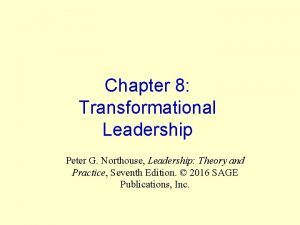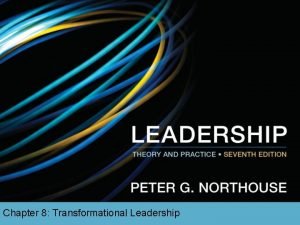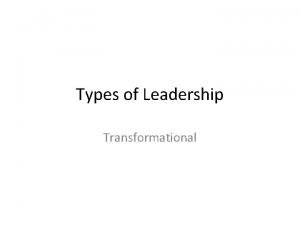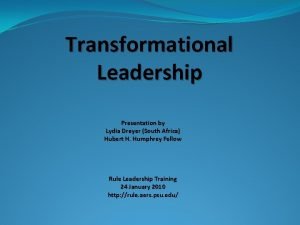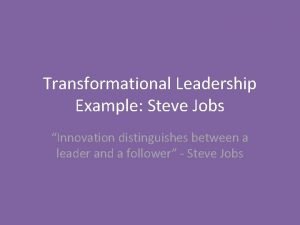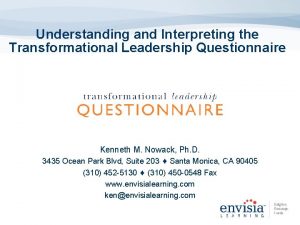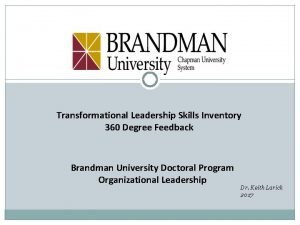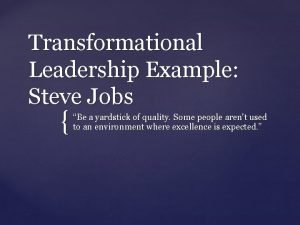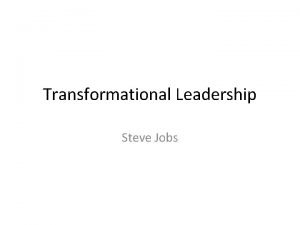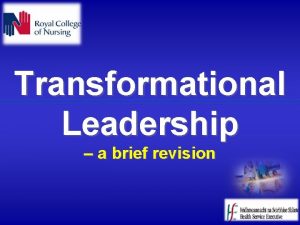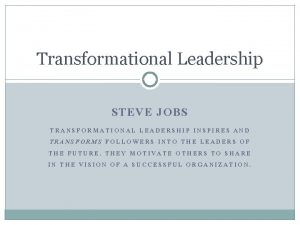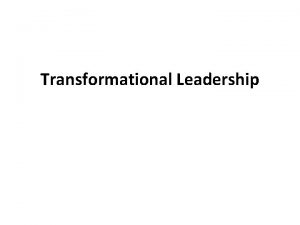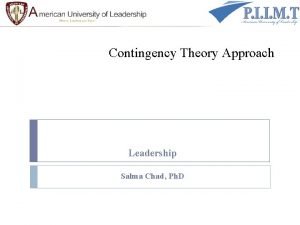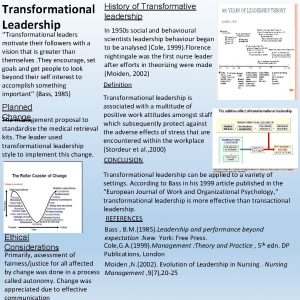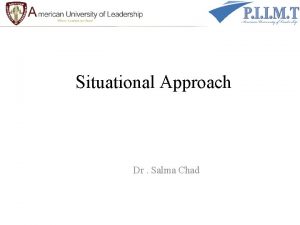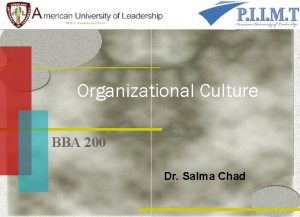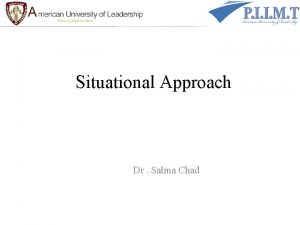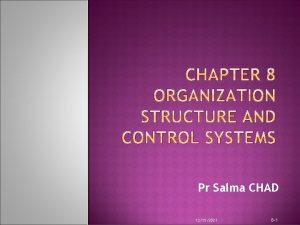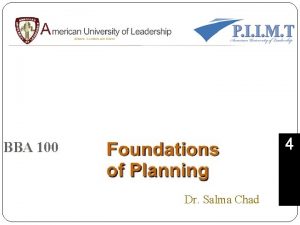Leadership Chapter 9 Transformational Leadership Dr Salma Chad


























- Slides: 26

Leadership Chapter 9 – Transformational Leadership Dr. Salma Chad

Overview v Transformational Leadership (TL) Perspective v A Model of Transformational Leadership v Transformational Leadership Factors v Full Range of Leadership Model v The Additive Effects of TL v Other Transformational Leadership Perspectives v How Does the Transformational Approach Work?

Transformational Leadership Description • Process - TL is a process that changes and transforms individuals • Influence - TL involves an exceptional form of influence that moves followers to accomplish more than what is usually expected • Core elements - TL is concerned with emotions, values, ethics, standards, and long-term goals • Encompassing approach – TL describes a wide range of leadership influence where followers and leaders are bound together in the transformation process

Types of Leadership Defined Burns (1978) Focuses on the exchanges that occur between leaders and their followers TRANSACTIONAL Process of engaging with others to create a connection that increases motivation and morality in both the leader and the follower TRANSFORMATIONAL Focuses on the leader’s own interests rather than the interests of their followers PSEUDOTRANSFORMATIONAL

Types of Leadership Defined Burns (1978) Focuses on the exchanges that occur between leaders and their followers TRANSACTIONAL - No new taxes = votes. - Sell more cars = bonus. - Turn in assignments = grade. - Surpass goals = promotion. … v. The exchange dimension is so common that you can observe it at all walks of life.

Types of Leadership Defined Burns (1978) Focuses on the leader’s own interests rather than the interests of their followers v Leaders who are – transforming but in a negative way – self-consumed, exploitive, power-oriented, with warped moral values v includes leaders like § Adolph Hitler § Saddam Hussein PSEUDOTRANSFORMATIONAL

Types of Leadership Defined Burns (1978) v. Leader is attentive to the needs and motives of followers and tries to help followers reach their fullest potential. Mohandas Gandhi – raised the hopes and demands of millions of his people and in the process was changed himself TRANSFORMATIONAL Process of engaging with others to create a connection that increases motivation and morality in both the leader and the follower

Transformational Leadership Charisma & Definition • Charisma - A special personality characteristic that gives a person superhuman or exceptional powers and is reserved for a few, is of divine origin, and results in the person being treated as a leader (Weber, 1947) • Charismatic Leadership Theory (House, 1976) – Charismatic leaders act in unique ways that have specific charismatic effects on their followers

Theory of Charismatic Leadership (House, 1976)

Theory of Charismatic Leadership (Shamir, House, & Arthur, 1993) Later Studies • Charismatic Leadership – – Transforms follower’s self-concepts; tries to link identity of followers to collective identity of the organization • Forge this link by emphasizing intrinsic rewards & de -emphasizing extrinsic rewards • Throughout process leaders – Express high expectations for followers – help followers gain sense of self-confidence and self-efficacy

Model of Transformational Leadership Bass (1985) • Transformational Leadership Model – Expanded and refined version of work done by Burns and House. It included: • More attention to followers’ rather than leader’s needs • Suggested TL could apply to outcomes that were not positive • Described transactional and transformational leadership as a continuum – Extended House’s work by: – Giving more attention to emotional elements & origins of charisma – Suggested charisma is a necessary but not sufficient condition for TL

Model of Transformational Leadership Bass (1985) TL motivates followers beyond the expected by: ¶ raising consciousness about the value and importance of specific and idealized goals · transcending self-interest for the good of the team or organization ¸ addressing higher-level needs

Transformational Leadership Factors Leaders who exhibit TL: ¶have a strong set of internal values & ideals ·are effective in motivating followers to support greater good over self-interest

Full Range of Leadership Model

Transformational Leadership Factors The 4 “I”s • Idealized Influence - Acting as strong role models - High standards of moral and ethical conduct - Making others want to follow the leader’s vision • Inspirational Motivation - Communicating high expectations - Inspiring followers to commitment and engagement in shared vision - Using symbols & emotional appeals to focus group members to achieve more than self-interest

Transformational Leadership Factors The 4 “I”s • Intellectual Stimulation - Stimulating followers to be creative and innovative - Challenging their own beliefs and valuing those of leader and organization - Supporting followers to – try new approaches – develop innovative ways of dealing with organization issues • Individualized Consideration - Listening carefully to the needs of followers - Acting as coaches to assist followers in becoming fully actualized - Helping followers grow through personal challenges

Transactional Leadership Factors Contingent Reward v The exchange process between leaders and followers in which effort by followers is exchanged for specified rewards Management by Exception v Leadership that involves corrective criticism, negative feedback, and negative reinforcement – Two forms § Active - Watches follower closely to identify mistakes/rule violations § Passive - Intervenes only after standards have not been met or problems have arisen

Nonleadership Factor Laissez-Faire v The absence of leadership v A hands-off, let-things-ride approach v Refers to a leader who – abdicates responsibility – delays decisions – gives no feedback, and – makes little effort to help followers satisfy their needs

Additive Effect of Transformational Leadership

Bennis & Nanus (1985) • Four Leader Strategies in Transforming Organizations ¶ Clear vision of organization’s future state · TL’s social architect of organization ¸ Create trust by making their position known and standing by it ¹ Creatively deploy themselves through positive selfregard

Kouzes & Pozner (1987, 2002) • Model consists of 5 fundamental practices ¶ · ¸ ¹ º Model the Way Inspire a Shared Vision Challenge the Process Enable Others to Act Encourage the Heart

How Does the Transformational Leadership Approach Work? v Focus of Transformational Leadership v Strengths v Criticisms v Application

Transformational Leadership Focus of Transformational Leaders Overall Scope • TLs empower and nurture • Describes how leaders followers can initiate, develop, • TLs stimulate change by and carry out becoming strong role significant changes in models for followers organizations • TLs commonly create a vision • TLs require leaders to become social architects • TLs build trust & foster collaboration

Strengths • Broadly researched. TL has been widely researched, including a large body of qualitative research centering on prominent leaders and CEOs in major firms. • Intuitive appeal. People are attracted to TL because it makes sense to them. • Process-focused. TL treats leadership as a process occurring between followers and leaders. • Expansive leadership view. TL provides a broader view of leadership that augments other leadership models. • Emphasizes follower. TL emphasizes followers’ needs, values, and morals. • Effectiveness. Evidence supports that TL is an effective form of leadership.

Criticisms • Lacks conceptual clarity – Dimensions are not clearly delimited – Parameters of TL overlap with similar conceptualizations of leadership • Measurement questioned – Validity of MLQ not fully established – Some transformational factors are not unique solely to the transformational model • TL treats leadership more as a personality trait or predisposition than a behavior that can be taught • TL is elitist and antidemocratic • Suffers from heroic leadership bias • TL is based primarily on qualitative data • Has the potential to be abused

Application • Provides a general way of thinking about leadership that stresses ideals, inspiration, innovations, and individual concerns • Can be taught to individuals at all levels of the organization • Able to positively impact a firm’s performance • May be used as a tool in recruitment, selection, promotion, and training development • Can be used to improve team development, decision-making groups, quality initiatives, and reorganizations • The MLQ helps leaders to target areas of leadership improvement
 Transactional vs transformational
Transactional vs transformational Northouse 2016 transformational leadership
Northouse 2016 transformational leadership Full range leadership model
Full range leadership model Transformational leadership kouzes and posner
Transformational leadership kouzes and posner Steve jobs influence
Steve jobs influence Is steve jobs a transformational leader
Is steve jobs a transformational leader Smooth running
Smooth running Transformational leadership factors the 4 i's
Transformational leadership factors the 4 i's Howard schultz leadership style
Howard schultz leadership style Transformational leadership
Transformational leadership Transformational synonym
Transformational synonym Transformational leadership presentation
Transformational leadership presentation Transformational leadership steve jobs
Transformational leadership steve jobs Transformational leadership questionnaire (tlq)
Transformational leadership questionnaire (tlq) Howard schultz transactional leadership
Howard schultz transactional leadership Northouse leadership skills inventory
Northouse leadership skills inventory Four i's of transformational leadership
Four i's of transformational leadership Steve jobs transformational leadership
Steve jobs transformational leadership Transformational leadership
Transformational leadership Transcendent leadership vs transformational
Transcendent leadership vs transformational Steps for transformational leadership
Steps for transformational leadership Mahatma gandhi transformational leader
Mahatma gandhi transformational leader Steve jobs transformational leadership
Steve jobs transformational leadership Define transactional leadership
Define transactional leadership Yeni ayat
Yeni ayat Salma georgia capitals
Salma georgia capitals Pretty salma summary
Pretty salma summary

